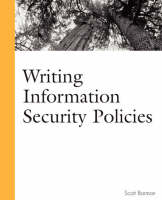
Writing Information Security Policies
New Riders Publishing (Verlag)
978-1-57870-264-0 (ISBN)
- Titel ist leider vergriffen;
keine Neuauflage - Artikel merken
Administrators, more technically savvy than their managers, have started to secure the networks in a way they see as appropriate. When management catches up to the notion that security is important, system administrators have already altered the goals and business practices. Although they may be grateful to these people for keeping the network secure, their efforts do not account for all assets and business requirements Finally, someone decides it is time to write a security policy. Management is told of the necessity of the policy document, and they support its development. A manager or administrator is assigned to the task and told to come up with something, and fast! Once security policies are written, they must be treated as living documents. As technology and business requirements change, the policy must be updated to reflect the new environment--at least one review per year. Additionally, policies must include provisions for security awareness and enforcement while not impeding corporate goals. This book serves as a guide to writing and maintaining these all-important security policies.
Scott Barman is currently an information Security and Systems Architecture Analyst for The MITRE Corporation (http://www.mitre.org). He has been involved with information security for almost 20 years, nurturing the evolution of systems and their security requirements for commercial organizations and government agencies. Since the explosion of the Internet and prior to joining MITRE, he had focused on various areas of security and policy development for many organizations in the Washington, D.C. area. The inspiration for this book came from his SANS '99 presentation. He earned his undergraduate degree from the University of Georgia and a Masters of Information Systems Management from Carnegie Mellon University (http://www.mism.cmu.edu). The reviewers contributed their considerable hands-on expertise to the entire development process for Writing Information Security Policies. As the book was being written, these dedicated professionals reviewed all the material for technical content, organization, and flow. Their feedback was critical to ensuring that Writing Information Security Policies fits our reader's need for the highest-quality technical information. David Neilan has been working in the computer/network industry for over 10 years, the last six dealing primarily with network/Internet connectivity and security. From 1991 to 1995, he worked for Intergraph, dealing with graphics systems and networking. From 1995 to 1998, he was with Digital Equipment, working with DEC firewalls and network security. From 1998 to 2000, he was with Online Business Systems, doing LAN/WAN and Internet security. David is currently running a business, Security Technologies, in the network/security realm; he is working with local companies to enable and secure their networks. He is designing network infrastructures to support secure LAN/WAN connectivity for various companies utilizing Microsoft 2000 and Cisco products and the Internet to create secure Virtual Private Networks. David also has been beta testing Microsoft operating systems since Windows For Workgroups, WFW3.11, and has worked part-time as a technical editor on many Microsoft/networking/security books. Larry Paccone is a Principal National/Systems Security Analyst at Logicon/TASC. As both a technical lead and project manager, he has worked in the Internet and network/systems security arena for more than eight years. He has been the technical lead for several network security projects supporting a government network/systems security research and development laboratory. Prior to that, Larry worked for five years at The Analytical Sciences Corporation (TASC) as a national security analyst assessing conventional military force structures. He has an M.S. in Information Systems, an M.A. in International Relations, and a B.A. in Political Science. He also has completed eight professional certifications in network and systems security, internetworking, wide area networking, Cisco routing/switching, and Windows NT.
(NOTE: Each chapter concludes with a Summary.)I. STARTING THE POLICY PROCESS.
1. What Information Security Policies Are.
About Information Security Policies. Why Policies Are Important. When Policies Should Be Developed. How Policies Should Be Developed.
2. Determining Your Policy Needs.
Identify What Is to Be Protected. Identify From Whom It Is Being Protected. Data Security Considerations. Backups, Archival Storage, and Disposal of Data. Intellectual Property Rights and Policies. Incident Response and Forensics.
3. Information Security Responsibilities.
Management Responsibility. Role of the Information Security Department. Other Information Security Roles. Understanding Security Management and Law Enforcement. Information Security Awareness Training and Support.
II. WRITING THE SECURITY POLICIES.
4. Physical Security.
Computer Location and Facility Construction. Facilities Access Controls. Contingency Planning. General Computer Systems Security. Periodic System and Network Configuration Audits. Staffing Considerations.
5. Authentication and Network Security.
Network Addressing and Architecture. Network Access Control. Login Security. Passwords. User Interface. Access Controls. Telecommuting and Remote Access.
6. Internet Security Policies.
Understanding the Door to the Internet. Administrative Responsibilities. User Responsibilities. World Wide Web Policies. Application Responsibilities. VPNs, Extranets, Intranets, and Other Tunnels. Modems and Other Backdoors. Employing PKI and Other Controls. Electronic Commerce.
7. Email Security Policies.
Rules for Using Email. Administration of Email. Use of Email for Confidential Communication.
8. Viruses, Worms, and Trojan Horses.
The Need for Protection. Establishing the Type of Virus Protection. Rules for Handling Third-Party Software. User Involvement with Viruses.
9. Encryption.
Legal Issues. Managing Encryption. Handling Encryption and Encrypted Data. Key Generation Considerations. Key Management.
10. Software Development Policies.
Software Development Processes. Testing and Documentation. Revision Control and Configuration Management. Third-Party Development. Intellectual Property Issues.
III. MAINTAINONG THE POLICIES.
11. Acceptable Use Policies.
Writing the AUP. User Login Responsibilities. Use of Systems and Network. User Responsibilities. Organization's Responsibilities and Disclosures. Common-Sense Guidelines About Speech.
12. Compliance and Enforcement.
Testing and Effectiveness of the Policies. Publishing and Notification Requirements of the Policies. Monitoring, Controls, and Remedies. Administrator's Responsibility. Logging Considerations. Reporting of Security Problems. Considerations When Computer Crimes Are Committed.
13. The Policy Review Process.
Periodic Reviews of Policy Documents. What the Policy Reviews Should Include. The Review Committee.
IV. APPENDIXES.
Appendix A. Glossary.
Appendix B. Resources.
Incident Response Teams. Other Incident Response Information. Virus Protection. Vendor-Specific Security Information. Security Information Resources. Security Publications. Industry Consortia and Associations. Hacker and “Underground” Organizations. Health Insurance Portability and Accountability Act. Survivability. Cryptography Policies and Regulations. Security Policy References.
Appendix C. Sample Policies.
Sample Acceptable Use Policy. Sample Email Security Policy. Sample Administrative Policies.
Index.
| Erscheint lt. Verlag | 12.11.2001 |
|---|---|
| Sprache | englisch |
| Maße | 229 x 179 mm |
| Gewicht | 363 g |
| Themenwelt | Informatik ► Theorie / Studium ► Kryptologie |
| Wirtschaft ► Betriebswirtschaft / Management ► Unternehmensführung / Management | |
| ISBN-10 | 1-57870-264-X / 157870264X |
| ISBN-13 | 978-1-57870-264-0 / 9781578702640 |
| Zustand | Neuware |
| Haben Sie eine Frage zum Produkt? |
aus dem Bereich


